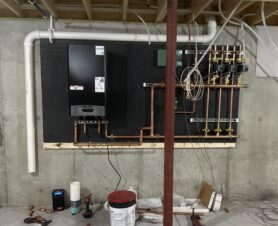Well, not exactly.
It’s like asking the federal government, during times of a major budget deficit, to arbitrarily print more money. It just doesn’t work that way, or it just can’t.
Recently, I sat in on the annual Plumbing Industry Leadership Coalition (PILC), and as the topic of the water conservation as it related to the California drought came up, I couldn’t help but think that, as we move toward a more water conservative mindset, is it really responsible for governing bodies to legislate lower gallons per flush, for example, without doing its due diligence and conducting the proper research?
In the extreme case of the drought in California, the state has been diligently working to enforce water consumption. State experts have been managing water resources to deal with the effects of the drought and prepare for the next one. As part of the solution, the California Energy Commission approved standards for water appliances, which will save more than 10 billion gallons of water in the first year. Over time, the water savings is estimated to reach 105 billion gallons per year — a savings of more than three times the annual amount of water used by the City of San Francisco.
The energy efficiency and water standards approved require water appliances to consume less water thereby using less energy while performing the same function. The details for each appliance are as follows:
• Toilets and urinals, except those designed for prisons or mental health facilities.
• Toilets shall not consume more than 1.28 gallons per flush and shall have a waste extraction score of no fewer than 350 grams. Urinals shall not consume more than 0.125 gallons per flush. (These facilities have specially-designed toilets and urinals to address security and health issues.)
• Residential lavatory faucets shall not exceed 1.2 gallons per minute flow rate.
• Kitchen faucets shall not exceed 1.8 gallons per minute flow rate and may have capability to increase to 2.2 gallons per minute momentarily for filling pots and pans.
• Public lavatory faucets shall not exceed 0.5 gallon per minute flow rate.
Extreme case such as this call for extreme measures. But often times more low flow legislation across the board can have potentially catastrophic results.

The Plumbing Efficiency Research Coalition (PERC) has announced its intention to launch a Phase 2 study, building upon the results of its successful and much-anticipated Drainline Transport Study (available on the PERC website: http://www.plumbingefficiencyresearchcoalition.org)
Pete DeMarco, senior vice president of Advocacy and Research, The IAPMO Group—and founder of the Plumbing Efficiency Research Coalition (PERC)—says the point of “diminishing returns” with low flow fixtures is dependent on the building, and how water is used in that building. Plumbing systems vary greatly by age, materials, design and quality of the original installation. “For example, the retrofitting of water-guzzling 3.5 gallon per flush (gpf) toilets and 1.0 or higher gpf urinals with high efficiency models in building is happening every day across the country. The overwhelming majority of the plumbing systems in these buildings continue to work just fine after the retrofit, but a few experience problems with chronic clogging of the building drain,” says DeMarco.
According to Ron George, CPD, president, Plumb-Tech Design & Consulting Services LLC, more technical research and increased water rates are needed to address water conservation methods. According to the United Nations Food and Agriculture Organization, more than eight billion people will inhabit the earth by the year 2030, requiring 60% more food and a significant increase in water over today’s capacities. “Increased water rates will give us the funds to support the needed infrastructure improvements and provide incentives for water conservation. We should mandate research and technical data before allowing any politician to reduce water and waste flows to unrealistic levels,” says George.
These new ultra-low-flow fixtures and appliances in conjunction with waterless urinals and greywater systems are creating health and safety problems from drain blockages in the name of water conservation, continues George. Continual reductions of water flows in the plumbing systems of buildings, however, have resulted in the phenomenon known as dry drains, where drain flows may be insufficient to effectively transport solids down the drain.
“There needs to be enough water in the river to float the boats. If we reduce the drainage flow volume and leave the drain pipes the same size then the hydraulic depth of flow will be less,” says George. In older buildings there will likely be more problems than in newer buildings. In new buildings drain sizes can be designed smaller and the minimum slopes can be designed with greater slopes.
On the supply side, the issues are more complex and more concerning. Water quality decreases as the transit time between the point of treatment at the water utility and the point of use in a building increases. The lower flow rates associated with efficient plumbing fixtures and appliances result in lower water velocities in supply pipes, which can contribute to biofilm growth, which in turn can amplify the growth of dangerous pathogens such as legionella. There have been studies that show extremely long water residence times in commercial building supply systems due to oversized pipes and decreased water use. “What we don’t know is to what extent these problems are causing harm,” says DeMarco.
In addition, recent water use reduction efforts are creating an unhealthy environment and a non-sustainable condition for drain line transport, which is a serious health and safety issue. “The arbitrary reductions in fixture flow rates without any technical justification for these reductions is placing drain line transport of solids wastes in serious jeopardy. Water use reductions seem to be out of balance with reality. The arbitrary percentage increment reductions in water usage to gain points seem to have no scientific basis,” says George.
Most experts would agree that water efficiency is not optional. The answer to these problems is not to turn back the clock on the use of water efficient fixtures and appliances. “Water scarcity and declining water quality are only going to get worse in the years to come. We need to work together and determine how we can maintain safety and efficacy while being as efficient as possible,” says DeMarco.
 John Mesenbrink is president and co-owner of Mechanical Hub. He has been covering the trades for more than 17 years and has been covering the plumbing & heating industry for more than 12 years.
John Mesenbrink is president and co-owner of Mechanical Hub. He has been covering the trades for more than 17 years and has been covering the plumbing & heating industry for more than 12 years.




Join the conversation: